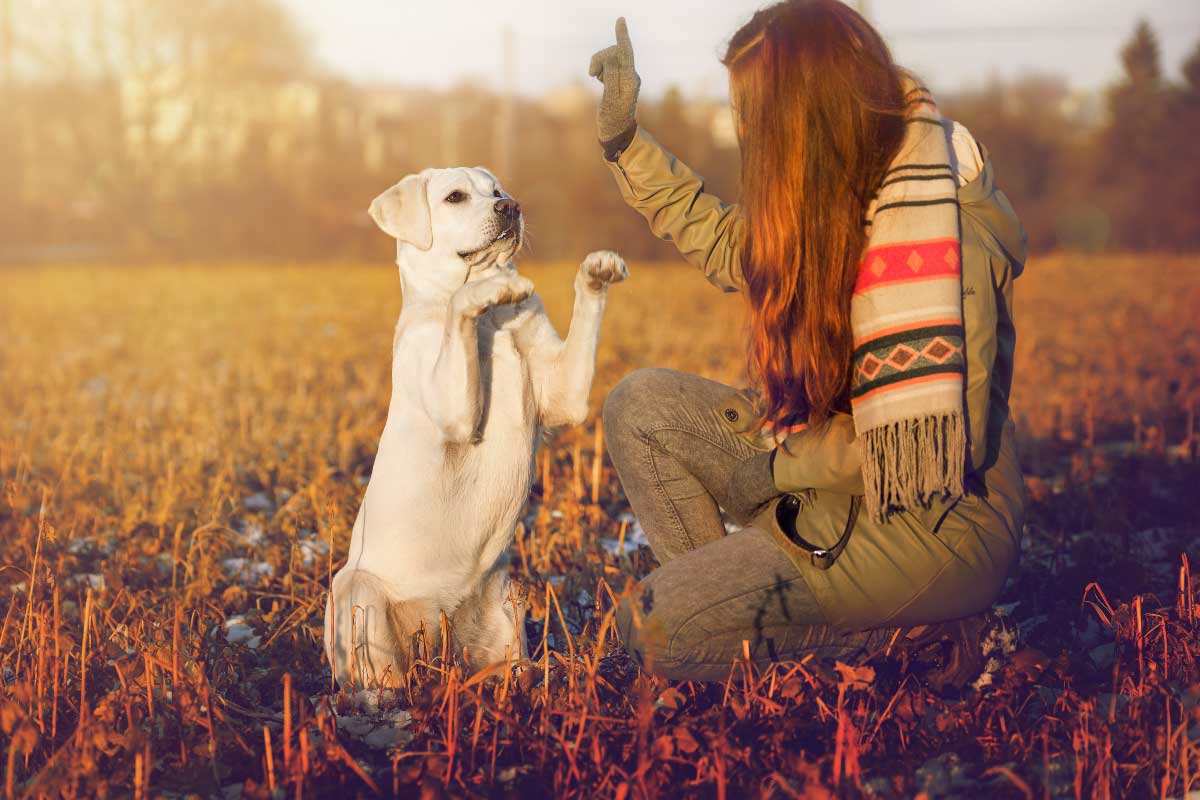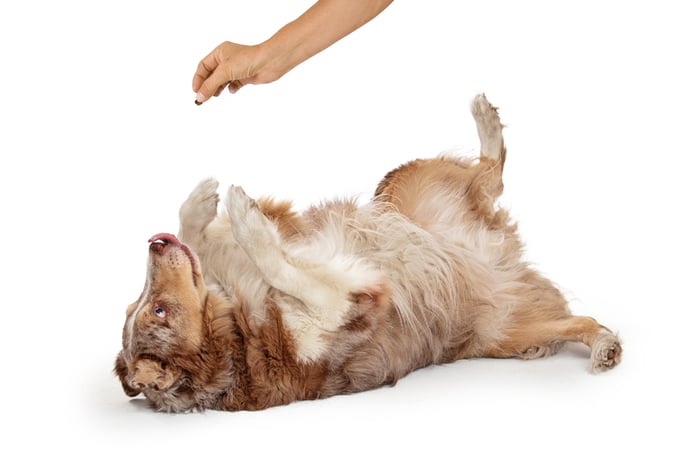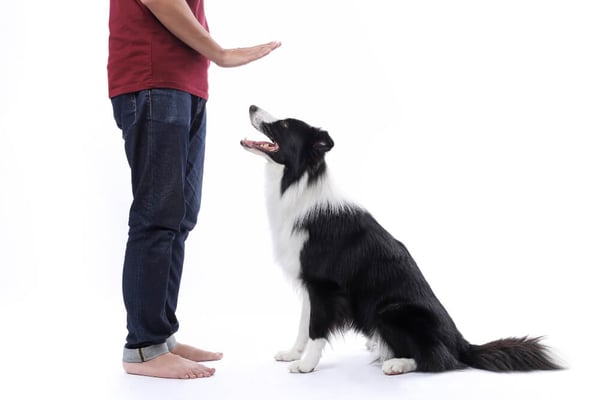
Teaching basic dog commands doesn't have to be a struggle. Traditional treat training is fun, but you can enhance your dog's training by using hand signals for dogs.
Teaching hand signals further solidifies the canine/human bond and takes your communication skills to a whole new level with your pet.
Whether you are training a new puppy or just giving your old dog a refresher course, hand signals are a great way to teach your dog quicker and broaden their skills.
In this blog post, we will explore the use of dog training hand signals and how to effectively teach them. Whether you are looking to improve your dog's focus during training, nail down tricky skills, or just add another engaging and fun aspect to your dog's training, these tips are sure to bolster your training routine.
Benefits of Dog Sign Language
Training is an important part of puppyhood, but dog training doesn't stop when they reach adulthood. Teaching your older dog new tricks or practicing lesser-used skills is a great way to enhance their daily routine and encourage mental stimulation.
Regular dog training can relieve dog boredom and anxiety, and ensure your dog has good manners and safer habits.
Dogs often struggle to learn verbal communication. As time goes by, they learn certain words, but tone and background noise can make it harder for your dog to acknowledge verbal prompts. If your dog sometimes seems to ignore or "forget" certain vocal cues, then hand signals are a great way to reinforce and simplify.
Canines appear to learn hand signals more easily than verbal commands. In fact, dogs tend to respond better when you pair hand signals with auditory commands.
One study found that dogs learn how to effectively respond to voice commands with an impressive 82% accuracy, but they respond to dog sign language commands 99% of the time.
Additional reasons to try dog sign language to help train your dog:
-
- Provides the ability to give a command in a noisy environment where your dog can’t hear you clearly.
- Ability to compete in competitive obedience sports (hand signals are often required).
- An effective way to communicate with a deaf dog.
- Teaching hand signals is a fun activity.
- Command your dog at a distance without needing to shout.
- Increases your furry friend’s focus on you with a visual cue.
Whether you are just starting out or refreshing skills for your already trained pooch, using dog sign language can be a fun and effective option for both hearing and hearing-impaired pets.
Tools for Training Basic Dog Commands
The process for training hand signals is not that different from teaching with just vocal commands. You want to demonstrate the hand signal while using the vocal cue and wait for a response. When your dog responds appropriately, you reward immediately.
With a little practice, your dog will quickly associate the hand motion with the action that gets them their snack or praise.
That being said, it's important to use high-value rewards to help your dog's brain make that connection. Dog treat training is the most effective for most dogs, so keep a stash or treat pouch of small and extra tasty dog training treats on your person while training.
The quicker you can respond with the reward, the easier it will be for your pooch to link the good feelings of the treat to the action they displayed.
Here are a few of our top-selling dog training treats that you can use while teaching hand signals for dogs:
Other tools that can come in handy include treat training pouches, training clickers, target sticks or the Homes Alive Pets Easy Squeeze Treat Tube.
These tools can make quick treating and rewarding easier as you practice your dog's new hand signals.
Top Hand Signals for Dogs

Canines are visually oriented. They watch and learn about the world around them. Teaching your dog hand signals along with vocal cues can help them easily learn to recognize various gestures and learn new dog tricks and skills faster.
Using dog sign language commands coupled with verbal instructions, you’ll enhance the trust between you and your furry buddy. Your dog will become a better companion, and you’ll feel more confident in the training process.
Here are some of the top hand signals for training dogs:
1. Watch Me
When training, you want your dog’s eyes on you. If you plan on using only nonverbal cues and halting auditory commands, then it is essential that your pooch watches you closely.
Teach your dog the command ‘look’, or whatever word or short phrase you choose, so they know to keep their eyes on you for an upcoming command.
Hold a treat in your palm and wait for your dog to look directly at you. When your dog’s eyes focus on the treat, then raise your hand to your face and point to your eye. Your dog will watch the treat hand and start looking at your hand closely. Once the dog’s eyes are on your face, then reward with a treat.
The ‘watch me’ is one of the leading dog obedience hand signals and should be the first thing you teach your pup.
Once your dog can consistently follow the treat to your face, practice the same motion without the treat. If your dog looks, reward immediately.
2. Sit Signal
The sit-hand signal is essential for any dog, and it's one of the easiest to master. Teaching the dog sign language for sit is one of the easier ones to start with. Hold a treat in front of your dog's nose and raise your hand slightly up and back. Your dog will naturally raise his head and lower his bum to follow the treat.
Start close to his face to prevent other behaviours like backing up or jumping. Once your dog has mastered this skill, start to swipe your hand up higher and higher until you get to about chest height.
Next, practice doing the same motion with your hand open and your palm facing up. With a little practice, your dog will learn to associate the hand shape and motion with the action of sitting. You can gradually phase out the treat.
Here's a helpful video of the process:
3. Come Command
The come command is still one of the most important commands to train a dog. Teach the dog to come to you by starting with your hand held open by your side. Then bring the hand up diagonally to your opposite shoulder.
You can start by showing your dog a treat to get their attention, and then draw the hand with the treat up to your shoulder. Use the verbal ‘come’ command until your dog starts to associate the motion with the command. After some practice, you can phase out the treat and the verbal command.
4. Stand
Many pet owners never think about training their dogs to stand back up after they are in a down position. However, your dog can never know too many commands. When teaching your dog to sit, you hold a treat in your hand near your dog’s nose and draw it up and forward towards them. The stand command is the opposite.
From either a lying or sitting position, hold a treat in front of your dog and draw it back towards your thigh. If your dog wants the treat, he will have to stand to move forward and retrieve the snack. After some practice, you can start doing the same motion, but with your hand open, palm facing forward.
Once your dog understands the shape and motion of your hand, you can phase out the treat and verbal cue.
5. Lie Down Command
One of the most common commands used when training a dog is the lie-down command. To teach the hand signal to lie down, hold a treat in your hand and point one finger to the ground in front of your dog.
In the beginning, you will likely have to bend and almost touch your finger to the ground so that your dog follows the treat. Treat as soon as your dog lies down. With some practice, you can start holding your pointed finger higher above the floor while still asking for the down command.
6. Stay
Stay is one of the most basic signals for dogs. Any time your dog goes out into public with you, the stay can come in handy.
To teach the stay command, raise your hand with your palm open and facing your dog like you are saying stop. When you first get started, it can be helpful to use big, exaggerated movements, and as your dog learns, you can switch to a more subtle hand gesture.
Every time your dog responds to the 'stay' command, you should immediately give the pooch ample praise or a treat. As your dog gets the hang of it, you can practice their command from slightly further away to test their skills.
7. Heel Command
When you go for a walk with your dog, you want the pooch to walk beside you for safety and to behave like a good canine citizen. Start by showing your dog the treat and use the treat to walk your dog to your hip.
If your dog is facing you when you start, you can use a large circular hand motion to lead your dog out, back, and beside you. Don't treat until your dog is beside you and facing the right way. This might require a fair bit of practice to smooth out the wrinkles.
When you are ready, start ending the movement with a closed fist, tapping your hip. Then treat. You can start making your hand motions less and less exaggerated, while still ending with a closed-fist hip tap. In time, your dog will be able to respond to just the hip tap.
8. Drop It
The drop-it command is a necessity for any pet owner because it could save your pup’s life. If your dog picks up something that is poisonous or that could injure the animal, you’ll need the doggo to drop the item at once. Also, the 'drop it' command helps make a game of fetch more enjoyable when you tell Fido to drop the ball.
This trick is taught in sections. First, you want to associate the hand signal and vocal cue with a reward. Hold your hand out in a fist, palm up, and open your hand flat. Say drop or leave (pick one), and treat immediately.
Now you need to try it while your dog is holding something in his mouth. Give him a toy and follow the same steps as above. Your dog should drop the toy, knowing that there is a treat coming with the word and hand motion.
With enough practice, you should be able to drop the vocal cue so long as your dog is close by.
9. Spin or Rollover

Spin is a fun command and not essential. However, it's a fun trick to learn and one that adds a little play to your dog's training. Use a treat and move it in a horizontal, circular motion around your dog. Your dog will spin to follow the treat.
Use wider and slower circles at first, and then make your circle smaller and smaller as your dog gets better at the trick. Eventually, you should be able to make a small circle in the air above your dog's head, and your dog will know exactly what you are asking.
The action for rollover is basically the same. Do the same hand signal while your dog is lying down, but instead of making a horizontal circle, do a vertical diagonal motion. Using the verbal command roll or over is better suited to this trick.
You can break rollover down into three steps if your dog isn't doing a full circle. Start with the lay down command, then do your rollover hand signal to get your dog to roll from one side to the other. Finish with the stand command for the full motion.
10. All Done!
The ‘all done’ command (often referred to as the free command or the release command) lets your dog know that the training session is done. Fido can run and play.
To implement the hand signal, simply bring both hands up to shoulder level with palms out and say "All Done". This should be followed up by immediately offering an alternative activity. Toss your dog a toy or grab the leash and go for a walk together.
This is a great way to transition to a new activity and let your dog know it's ok to break focus on you and your instructions.
Using Hand Signals in All Your Dog Training
These hand signals work well for lots of basic dog tricks, but don't be afraid to incorporate these visual cues into your other dog training routines.
Recall training for dogs, for example, will utilize the come and heel commands. Drop it is excellent for keeping your dog safe around human foods and from finding "surprise snacks" on walks. Sit and stay hand signals can help when you are trying to train better social skills in a dog with leash aggression.
Although these specific tricks and dog sign language tips may seem pretty basic, each of these skills can be applied to other aspects of training, behaviour, and general safety. The more practiced your dog is with these skills and visual cues, the easier it will be to apply them in more situations.
Tips on Hand Signals for Dogs
Using hand signals for dogs might sound like a daunting task, especially when you and your pooch are new to training, but you'll be surprised at how easily many of the steps will come together.
Over time, your dog will associate the hand signal with the verbal commands that your dog already knows, or will help your dog to learn new words and skills faster and more effectively. Once you've had some practice, you can try dropping the verbal command to test whether your dog will respond to the dog sign language by itself.
Here are a few bonus tips to make your dog's sign language lessons more successful:
-
- Always train hand signals in a quiet and distraction-free area, such as an empty room or outdoors, with no disturbances.
- Make sure you have your dog’s complete attention. If they don't make eye contact, they probably won't be paying attention to the hand signals.
- Gain your dog's attention by using the pet’s name. No further tricks or skills can be taught until the look command is learned.
- Reward your dog’s good behaviour with high-value treats or toys, and follow up with verbal or physical praise.
- Remain consistently patient during training sessions. Your frustrations will contribute to your dog's frustrations, anxiety, or fear.
- Always give the hand signal first and then issue the verbal command. They should be very close together, but the visual cue should come slightly ahead.
- Practice short training sessions several times a week to keep the process fresh in your dog’s mind.
- Don't repeat commands too quickly. If your dog saw and heard the cue but hasn't budged, count to 5 in your head. Sometimes they just need a few seconds to think about what you are asking. Repeating the command over and over again may confuse your dog instead of clarifying your request.
Sometimes your dog will act out or start to disobey the visual commands. If this occurs, then it's time to go back to the beginning and start working on impulse control to ease anxiety on each command individually. Usually, it doesn’t take Fido long to pick up on the hand signals again.
Using standard dog training hand signals is a rewarding experience for both you and your pooch. Your pup wants to spend quality time with you, and while training may seem like work, it's both stimulating and engaging for dogs.
Working together to take the pet’s training to the next level with hand signals is a fun and fulfilling endeavour for both you and Fido.
Frequently Asked Questions
What is dog sign language?
Dog sign language, also known as canine sign language or signing with dogs, is a communication method using hand signals to convey commands and cues to dogs, often used alongside or instead of verbal commands.
Why might someone choose to use dog sign language with their dog?
Dog sign language can be beneficial for dogs with hearing impairments, puppies, and dogs that respond well to visual cues. It can also aid in training dogs in noisy environments.
Are there standardized dog sign language systems, or can individuals create their own signals?
There are standardized dog sign language systems like "American Sign Language for Dogs," but individuals can create their own signals as long as they are consistent and easily understood by the dog.
What are some common dog sign language commands or signals?
Common dog sign language signals include "sit," "stay," "come," and "lie down." These are the easiest to teach, but hand signals can be used for almost any skill or trick.
Can all dogs learn dog sign language?
Dogs of all breeds and ages, so long as they can see, can learn dog sign language, but it may be particularly useful for breeds prone to hearing problems or for puppies during training.
.png?width=200&height=66&name=logo%20(1).png)




